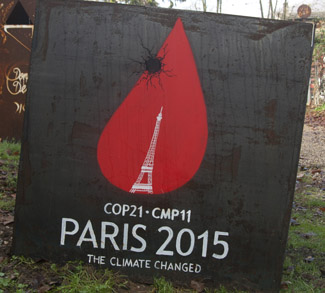The Paris Climate Change Conference might be the turning point in addressing climate change at the international level. The 21st Conference of Parties (COP21) is the annual meeting of the 195 nations that make up the United Nations Framework on Climate Change. The goal is to reach an agreement and set a target cap for carbon emissions at 450 ppm, limiting global warming within 2 degrees Celsius, which scientists designate as a critical threshold.
It is easy to be cynical about achieving such an international agreement. The Copenhagen 2009 conference will probably haunt the COP21 meeting, due to the failure of delivering a climate deal. Domestic politics and the unwillingness of states to be bound by a top-down decision, hammered in at the last minute between the United States, Brazil, China, South Africa and India, derailed the conference. That is why at this year’s conference the states adopted a bottom-up approach, with every country declaring their intended nationally determined contributions (INDCs). The problem is that, according to a UN synthesis report on the aggregate effect of INDCs, the commitments made so far by 147 countries will not reach the goal of limiting global warming to 2℃ above pre-industrial levels. These INDCs cover only about 85% of the existing emission levels and will not be sufficient to reverse the upward trend. The projections point to a 2.7℃ rise in temperatures. There is also no guarantee that countries will adhere to their commitments. International agreements often set aspirational goals and many countries derogate from their obligations when faced with adverse domestic conditions. The U.S. signed, but never ratified the Kyoto Protocol; Canada dropped out of it in 2011; while Russia and Japan decided not to assume further emissions limitations for the second phase of the protocol.
National governments are short-lived and the painful policies they have to implement carry significant political risks. The challenge of climate change is that it is a diffused threat, unfolding over decades, and it needs a long-term commitment. While the future benefits are accompanied by a large degree of uncertainty, the costs associated with overhauling existing energy systems are considerable and interfere with the near-term with goals of development and economic growth. Wealthy nations can afford to set aside a portion of GDP for transforming their transportation and electricity grids, but many developing countries do not enjoy this luxury. Their oil and power demand is only set to increase with future economic and population growth. Technological, institutional and financial constraints usually pressure developing nations to resort to the cheapest form of power generation – coal burning. While the United States and Europe are trying to force coal out of their energy mix, developing countries are readily expanding their coal consumption.
In the words of the World Coal Association’s COP21 position statement: “For most countries coal will continue to play a significant role whilst for many nations, particularly in industrializing and urbanizing Asia, coal has been identified as a growing fuel source and integral to their economic growth. By 2040, installed power generation capacity from coal will reach 2843GW compared to 1805GW today.”
The relatively cleaner alternative of natural gas is displacing coal in the U.S. and contributing to a drop in US CO2 emissions. However, before we embrace natural gas as a substitute for coal, we need to take into account the effect of methane leakages, which have been shown to vastly exceed previous EPA estimates.
Higher gas prices in Europe and the flawed Emission Trading Scheme (ETS) brought new coal-powered plants to the market. Even Germany, the leader in the greening of the power sector, added 8 GW of new coal plants after prematurely retiring the first 8.3 GW of nuclear capacities in 2011. The challenges accompanying this transition had the inadvertent effect of forcing the most efficient gas turbine in the world out of the electricity market. The preferential access of renewables to the power grid and the low price of carbon under the ETS are impediments to the introduction of more natural gas into the mix. Coal is something Europe may be able to curtail in the near future, but the rest of the world can easily offset Europe’s cut in CO2 emissions.
The US EIA points out that recent statistical revisions show China’s coal consumption on an energy-base to be 14% higher than previously reported. It illustrates how difficult gathering of emissions data is, and that estimates can be significantly off the mark. Environmental issues and social pressure could force the Chinese government to hasten the transition to cleaner power generation. The country currently consumes almost as much coal as the rest of the world combined. The government is making efforts to green-up energy production and is now the largest investor in renewable energy sources. But in absolute terms, China’s coal consumption is poised to grow even if its share falls from the present 77% to the projected 58% by 2035. China, India, and other Asian countries will be the main drivers of growth in coal consumption in the near future, easily offsetting the drop in the developed world.
A PWC report projects India as the third largest economy in 2050. If it is to become the world’s next factory, it will require massive amounts of energy. Moreover, if it repeats China’s industrialization model, coal is here to stay. The World Coal Association projects that installed power generation capacity from coal will reach 2,843 GW in 2040, a 60% increase compared to 2015. Growing populations and expanding economies will demand more energy in absolute terms even if technological advancements allow lower energy intensity per unit of GDP. Growing middle classes will increase consumption of electricity and oil. With over 300 million people lacking access to electricity in India alone, alleviating energy poverty will require massive investments in reliable power sources.
Renewable sources like solar and wind, when coupled with battery storage, are ideal for the transition towards a clean distributed power generation, but there are limits to their application in dense urban areas. Batteries can solve the temporal mismatch between generation and consumption, but if renewables are to be built on industrial scales, they will still face spatial constraints. Scaling renewables for the need of energy-intensive industries will require massive land areas and that will result in competition between agriculture, food production and power generation. Growing land and water scarcity will pose danger to food security. Densely populated developing countries cannot afford to forgo food production for expansion of renewable energy sources.
Aluminum and steel industries, fertilizers, cement production and chemicals are some of the most energy consuming economic activities. Outsourcing them to China has allowed developed countries to achieve reductions in domestic greenhouse gas emissions, but if we are to address the issue on a global level, this carbon leakage needs to stop.
In the words of the World Coal Association: “Coal is a critical enabler in the modern world. It provides 41% of the world’s electricity and is an essential raw material in the production of 70% of the world’s steel and 90% of the world’s cement. Fossil fuels today provide 81% of the world’s primary energy, a percentage not forecast to change significantly for decades to come.”
This is where carbon pricing comes into play. The social cost of carbon should reflect the marginal damage caused by an extra ton of CO2 emission. It could take the form of carbon taxes or tradable pollution permits. The European ETS has been a failure and it is in need of serious reform. Lowering the limits and setting a price floor for emission trading could give it a new life. Carbon taxes on imported goods are another solution, but calculating the carbon intensity of every single product is a computational nightmare. It might be easier to levy the carbon taxes upstream – at the point of energy production. A steady rising tax will send a clear signal to investors and force them to move away from carbon-intensive projects. Yearly incremental changes in the tax will mitigate market uncertainty and allow investors to incorporate the carbon price in their long-term planning. The rising social cost of carbon needs to be reflected in the tax. The marginal damage by an additional ton of emissions today is much smaller than the marginal damage that it will cause in 2050. Consequently, the carbon tax in 2050 will need to reflect that damage. It might not be a politically popular move, but carbon taxes can serve as a clear mechanism for addressing climate change. Agreement on taxes needs to be reached at the international level, in order to avoid carbon arbitrage and flight of industries to countries with lowest requirements. Carbon taxes on imports could solve the carbon leakage, but it will be much harder to implement. Current low energy prices present the ideal opportunity for instituting such a tax. The income effect will be much smaller and it will not generate the same pushback from consumers and vested interests as in a high-price environment. Nevertheless, countries with weak institutional structures might find it hard to compensate populations for the increased energy prices.
Previous efforts to reach an international agreement on climate change have been marred by fights over compensation mechanisms. Developing countries argue that the industrialized nations are to bear responsibility for the emissions they have pumped into the atmosphere so far, and insist on institutional help along with financial compensation in order to rein their own future emissions. A fund, financed by carbon taxes, could serve as such a compensation mechanism and incentivize developing economies to forego cheaper and heavy polluting power production in favor of cleaner, but more expensive technologies. Tax at the point of consumption in industrialized nations would be fairer and offset the carbon outsourcing problem.
The lesson from the European ETS is that, in addition to political solutions, we need serious technological advancements in order to limit carbon emissions.
No single technology that exists today, apart from nuclear, can bring us sufficient quantities of carbon-free electricity. Unfortunately, nuclear power has its own problems, stemming from accidents and long-lived radioactive waste. These problems could potentially be solved in the future by a new generation of modular reactors using molten salts. We also might be close to discovering the holy grail of energy – nuclear fusion, which could provide unlimited amounts of clean electricity. Nevertheless, nuclear generation is immensely capital-intensive and developing countries might not be able to afford it.
Current technologies provide room for incremental improvements and research and development could boost their efficiency. Carbon capture and storage (CCS) represent a range of technologies that could capture CO2 emissions from fuel combustion or industrial processes and store it underground. It is an area which governments should actively support and develop. So far, we have spent 2/3 of the carbon budget, which would keep temperatures below 2℃. If cumulative emissions exceed 1 trillion metric tons, global warming is likely to exceed 2℃. The majority of the proven reserves of coal, oil and gas will have to stay in the ground in order to avoid exceeding the carbon budget.
Developing CCS technologies could successfully mitigate the GHG problems associated with conventional power generation. It will allow the continuing usage of coal by emerging economies without sacrificing their future economic growth. Power generation by coal plants and energy intensive industries tend to be geographically concentrated. This makes them ideal candidates for CCS projects. However, the deployment of CCS technology is dependent on enabling policy framework. They are vastly expensive long-term projects and industries need proper support and signal from governments in order to invest in their development. Governments could leverage their own finances and instead of subsidizing the production of electricity, they could target funds towards mitigating the negative effects of conventional power production. The first successful large-scale CCS project at the Boundary Dam coal-fired power plant in Canada has been hailed by the IEA as historic. It will trap around 1 million tons of CO2 per year, which will be injected in nearby oil fields to enhance oil recovery. The potential of mitigating CO2 emissions through CCS projects is substantial and governments should institute an enabling and supporting policy framework for its development.
The solution to our climate change problem will have to come from both political and technological progress. Governments have a responsibility to address the issue at the international level and an agreement in Paris could be the start of a new era. The present national contributions will not be enough to reverse the global warming trend, but an agreement can serve as a framework for future improvements. Governments also need to be realistic about renewable energy sources and acknowledge the limitations to their scalability. Carbon price could serve the dual function of promoting renewables and incentivizing the cleanup of coal generation. Carbon capture and storage needs to become an indispensable part of governments’ policies addressing CO2 emissions. Developed countries need to invest in this technology and provide the expertise to developing nations if we are to avoid breaching of the 2℃ threshold.
The opinions, beliefs, and viewpoints expressed by the authors are theirs alone and don’t reflect any official position of Geopoliticalmonitor.com.




